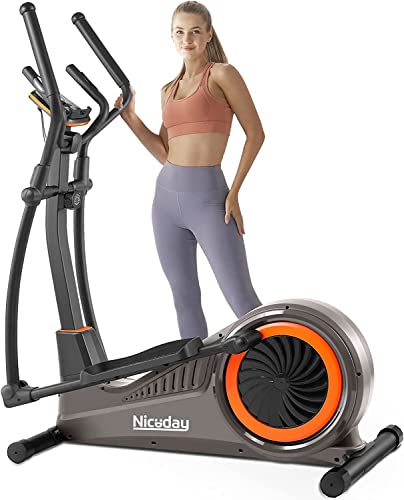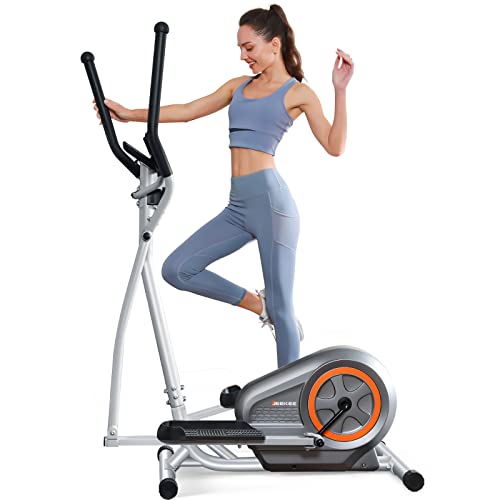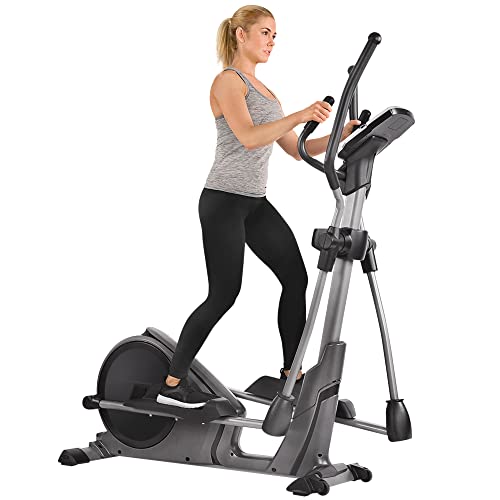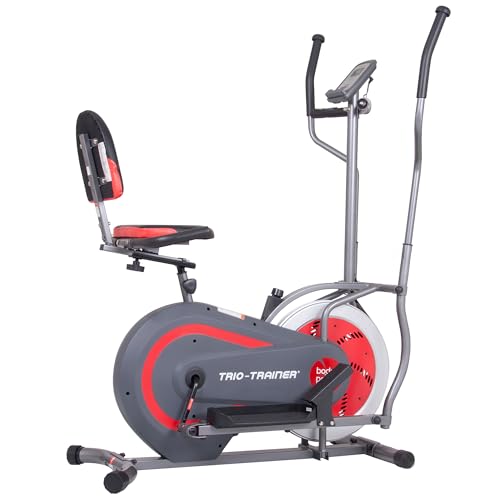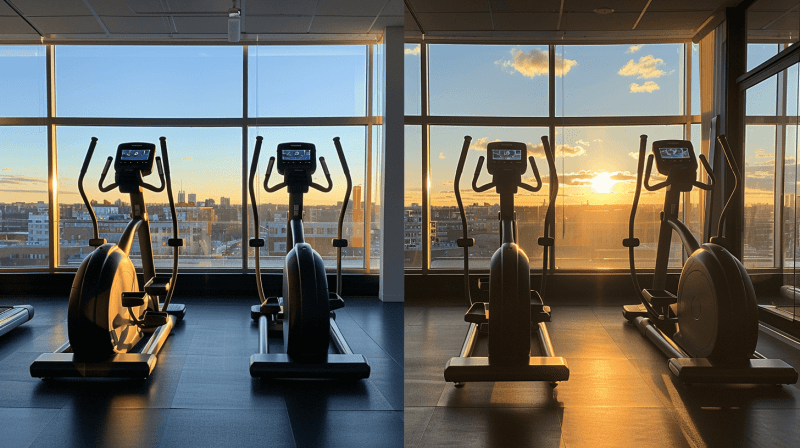Just as you've stepped onto your elliptical machine wondering about the right pace, thousands of other fitness enthusiasts are asking themselves the same question. You're not alone in seeking that sweet spot between effective training and sustainable effort. While the ideal pace varies considerably among individuals, you'll find that understanding your current fitness level and goals will help determine your optimal speed. Whether you're a beginner aiming to build endurance or an experienced user looking to maximize calorie burn, there's a specific range that'll work best for your needs. Let's explore how to find your perfect rhythm.
Key Takeaways
-
Beginners should maintain 60-70 RPM to build proper form and endurance, while advanced users can target 80-90 RPM.
-
The standard pace range falls between 60-90 RPM, with adjustments based on individual fitness levels and goals.
-
Higher resistance requires slower speeds (110-125 steps/minute), while lower resistance allows faster speeds (140-160 steps/minute).
-
Maintain a consistent 90 RPM rhythm during regular training to stabilize effort and simulate natural running mechanics.
-
Incorporate interval training by alternating between moderate pace (80 RPM) and recovery pace (60-70 RPM) for optimal results.
Understanding Elliptical Machine Pace
Fitness enthusiasts often wonder what pace they should maintain on an elliptical machine. When using elliptical machines, your stride rate, measured in revolutions per minutes (RPM), determines your overall speed and workout intensity. Understanding the right pace for your fitness level is essential for achieving optimal results during your training sessions.
The standard pace range for elliptical workouts falls between 60 and 90 RPM, but you'll need to adjust this based on your experience level. If you're new to using an elliptical, you should aim for 60-70 RPM in your first few minutes, which allows you to maintain proper form while building endurance. As you become more experienced, you can gradually increase your pace to 80-90 RPM.
Your chosen resistance level plays a significant role in determining your ideal pace. When you're working with higher resistance settings, you'll naturally maintain a lower RPM while still getting an effective workout. Remember that it's better to focus on maintaining a consistent, comfortable pace rather than pushing yourself to achieve the highest possible speed, especially when you're just starting. Try incorporating interval training techniques by alternating between moderate and recovery paces to maximize your cardiovascular benefits.
Beginner Pace Guidelines
New users of the elliptical machine will find comfort and success by following specific pace guidelines. When you're starting out, you'll want to aim for a beginner pace between 60-70 revolutions per minute (RPM), which provides an ideal foundation for building your fitness routine. This moderate cadence allows you to develop confidence while maintaining control of your movements.
You'll achieve the best results by starting at the lower end of the range, around 60 RPM, and gradually working your way up to 70 RPM as you become more comfortable with the motion. This progressive approach helps you maintain proper form throughout your workout, which is essential for preventing injury and maximizing benefits. Your focus should be on mastering the technique rather than pushing for speed too quickly.
Maintaining this controlled pace range of 60-70 RPM gives you the opportunity to establish a smooth, rhythmic motion on the elliptical. As you exercise within these guidelines, you'll notice that you're able to concentrate on your form while still getting an effective workout. This measured approach confirms you're building a strong foundation for more challenging workouts in the future. Remember to maintain an upright posture position throughout your workout to prevent strain and ensure optimal muscle engagement.
Advanced User Target Speeds
After mastering the fundamentals, advanced users should target a faster elliptical pace between 80-90 RPM to maximize their cardiovascular benefits. This increased speed closely mimics the natural stride rate of running, helping you achieve optimal training results on the elliptical machine while engaging multiple muscle groups effectively.
For more challenging workouts, you'll want to incorporate interval training at speeds between 85-92 RPM during moderate to high-intensity segments. Maintaining a steady cadence of 90 RPM during your regular training sessions will help build endurance and create a workout experience similar to running outdoors.
You can further enhance your elliptical workout by alternating between different speeds throughout your session. Try switching between a baseline pace of 80 RPM and bursts of 90+ RPM to target various muscle groups and energy systems. If you're highly conditioned, you can push your speed to 90-100 RPM during short, maximum-effort intervals to achieve peak cardiovascular responses.
These advanced speed targets will help guarantee you're getting the most out of your elliptical training sessions while continuing to improve your fitness level. The low-impact design of elliptical machines allows you to maintain these higher speeds without putting excessive strain on your joints.
Heart Rate Training Zones
Training by heart rate zones on the elliptical allows you to precisely target different fitness goals during your workout. Rather than focusing solely on speed, monitoring your heart rate provides a more accurate measure of your effort on the elliptical and helps guarantee you're training at the right intensity for your objectives.
The key training zones for elliptical workouts include:
- Resting to easy zone (65-75% max heart rate): Perfect for recovery days and building basic endurance
- Moderate intensity zone (87-92% max heart rate): Simulates a tempo run effort and improves lactate threshold
- Hard effort zone (95-100% max heart rate): Maximizes Oxygen consumption and develops speed through intense intervals
- Maximum zone: Reserved for very short bursts of all-out effort
To maintain your target heart rate zone effectively, aim to keep a consistent cadence of 90 RPM on the elliptical. This rhythm helps stabilize your effort level and prevents unnecessary fluctuations in heart rate. As you become more experienced, you'll learn to recognize how different zones feel and can adjust your intensity accordingly, making your workouts more efficient and goal-specific.
Using high-intensity interval training on the elliptical can significantly increase your fat-burning potential while cycling through different heart rate zones.
Resistance and Speed Relationship
While monitoring heart rate zones provides valuable intensity guidance, understanding the interplay between resistance and speed is fundamental for an effective elliptical workout. Most machines calculate average speed in steps per minute or miles per hour, but you'll need to take into account how resistance affects your overall rate of movement. When you increase the resistance, you'll naturally need to decrease your pace to maintain control and proper form.
Finding your ideal resistance and speed combination requires experimentation with different settings. You can start by adjusting resistance every few minutes while maintaining a consistent effort level. If you're working at a higher resistance setting, expect your speed on an elliptical to be slower, typically ranging from 110-125 steps per minute. Conversely, when using lower resistance, you can maintain faster speeds of 140-160 steps per minute.
To maximize your workout benefits, try incorporating interval training by alternating between high resistance with slower speeds and lower resistance with faster speeds. This approach helps you maintain an effective workout intensity while challenging different muscle groups and energy systems throughout your session. Maintaining tall upright posture throughout your workout helps ensure proper form and optimal results regardless of your chosen speed and resistance levels.
Proper Form for Speed
On the elliptical machine, proper form serves as the foundation for achieving and maintaining ideal speed. Your upright posture and core engaged position will help transfer power efficiently through your body while preventing unnecessary energy waste. When you're aiming to increase your stride speed, it's crucial to focus on leg drive rather than excessive upper body movement.
To maintain proper form while building speed, follow these key techniques:
- Keep your spine straight and shoulders relaxed while maintaining an upright posture throughout your workout
- Adjust resistance and incline settings gradually to match your target pace without compromising form
- Maintain a consistent stride length and cadence within 90 RPM for the best muscle engagement
- Avoid sudden increases in pace, allowing your body to adapt naturally to speed progression
Remember that your body's positioning directly impacts your performance and endurance. By focusing on proper form, you'll be able to maintain higher speeds more effectively while reducing the risk of injury. When you combine correct posture with appropriate resistance levels, you'll create a more efficient workout that targets the intended muscle groups while improving your overall cardiovascular fitness. The core muscle engagement during your elliptical workout helps enhance power generation and improves overall lifting performance in other physical activities.
Tracking Progress and Performance
Throughout your elliptical journey, tracking progress and performance serves as a critical component for achieving fitness goals. By monitoring your average speed during workouts, you'll gain valuable insights into your cardiovascular improvements and overall fitness development. This data-driven approach helps you make informed decisions about adjusting your training intensity and establishing realistic benchmarks.
Your workout performance tracking should account for various factors that influence average speed measurements. When you're documenting your sessions, remember that resistance levels and interval training patterns will affect your overall pace. For instance, a workout with high resistance might show a lower average speed but could actually represent a more challenging session than a faster-paced workout at lower resistance.
To effectively track your progress, maintain a consistent record of your workout data, including average speed, resistance settings, and interval patterns. You can use this information to identify trends in your performance and adjust your goals accordingly. When you notice improvements in your average speed while maintaining similar workout parameters, it's a clear indicator that your fitness level is advancing.
Common Speed Training Mistakes
Many elliptical users make avoidable mistakes when trying to improve their speed and performance. While speed is important, focusing solely on moving faster can lead to poor form and reduced workout effectiveness. Understanding your perceived exertion (RPE) and maintaining proper technique should always take priority over raw speed.
To avoid common training pitfalls, be aware of these frequent mistakes:
- Trying to work harder in every training session without allowing for proper recovery days
- Neglecting to incorporate interval training, which is essential for building both speed and endurance
- Maintaining the same speed throughout the entire workout instead of varying intensity
- Focusing on speed at the expense of proper form and resistance levels
Your progress on the elliptical requires a balanced approach that combines speed work with other training variables. Instead of trying to increase your pace every time you step on the machine, focus on creating structured workouts that alternate between high and low intensities. This strategy helps prevent burnout while maximizing the benefits of your cardiovascular training and allowing your body to adapt properly to increased demands.
Customizing Your Pace Goals
Setting realistic pace goals on the elliptical requires a personalized approach based on your current fitness level and training objectives. When you first use the elliptical, you'll want to aim for 60-70 RPM, which allows your body to adjust to the movement pattern and build proper form. As you become more comfortable with your elliptical workouts, you can gradually increase your pace to the 80-90 RPM range.
Your elliptical sessions should take into account the resistance level you're using, as this considerably impacts your ideal pace. If you're working with higher resistance, you'll need to maintain a slower cadence, while lower resistance settings allow for faster speeds. To help maximize your results, try to maintain a consistent rhythm of 90 RPM during your minutes easy segments to simulate natural running mechanics.
When customizing your pace goals, consider breaking down your workouts into intervals. You might start with 5-10 minutes at a beginner's pace, then gradually work up to longer durations and faster speeds as your fitness improves. This progressive approach guarantees you're challenging yourself while avoiding common overtraining mistakes.
Frequently Asked Questions
What Is a Good Pace on an Elliptical?
You'll want to maintain 60-90 RPM based on your fitness level. Adjust resistance and incline to reach your target heart rate range. Beginners should start at 60-70 RPM, while experienced users can pace 80-90 RPM.
What Is a Good Rpm for an Elliptical?
Ready to supercharge your elliptical workout? You'll want to maintain 60-90 RPM, starting at 60-70 if you're a beginner. More experienced users should aim for 80-90 RPM to maximize calorie burn and effectiveness.
Is It Better to Go Faster or Longer on an Elliptical?
You'll benefit from both approaches - go faster for high-intensity cardio and fat burn, or longer for endurance. Monitor your heart rate and adjust resistance, incline, and stride length based on your fitness goals.
How Many Minutes on an Elliptical Is Good?
Think you'll get a one-size-fits-all answer? You'll want 20-30 minutes if you're starting out, or 45-60 minutes when you're experienced. Focus on your target heart rate and adjust resistance for ideal benefits.
Conclusion
Properly pacing your elliptical workouts will promote peak performance and prevent potential problems. You'll want to start at 60-70 RPM as a beginner, steadily scaling up to 80-90 RPM as your strength and stamina improve. Whether you're maintaining a moderate pace or mixing in meaningful intervals, remember to respect your body's response and adjust accordingly. Track your progress, perfect your form, and you'll maximize the machine's many fitness benefits.

